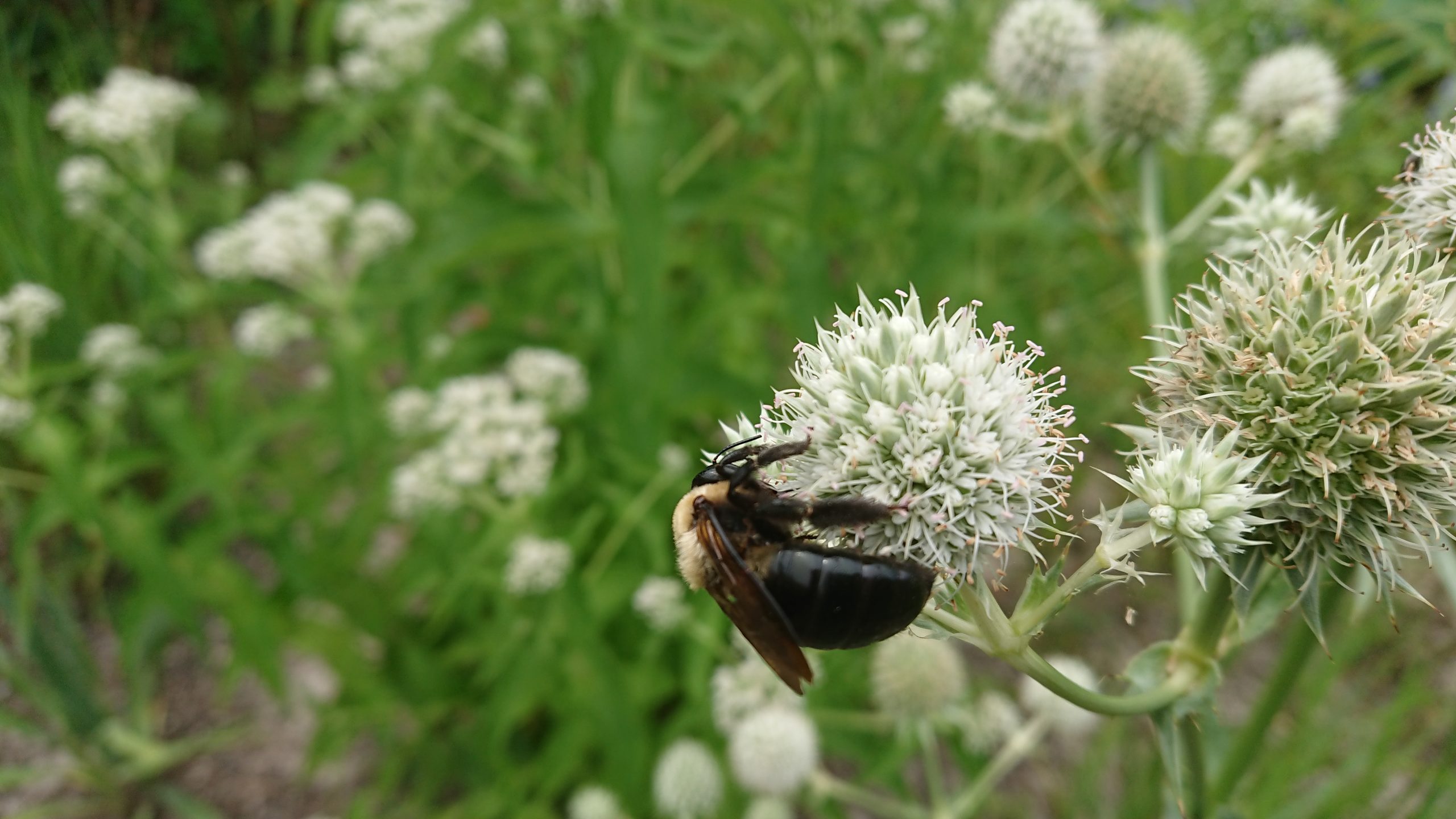Native Plants: An Elegant Solution
Along the eastern edge of Lake Sydnor, on the narrow strip of land between the shoreline and the Children’s Garden, a group of plants is hard at work. The beauty of the bed belies its greater purpose. The plants there are members of a “designed plant community” that mimics how different types of vegetation work together in the wild. Chosen for their ability to mitigate stormwater runoff from the Children’s Garden and provide food and shelter for local wildlife, they are helping to manage man’s impact on the environment. And while they are rooted on the Sydnor Lake shoreline, they will ultimately help improve water quality downstream, all the way to the Chesapeake Bay.
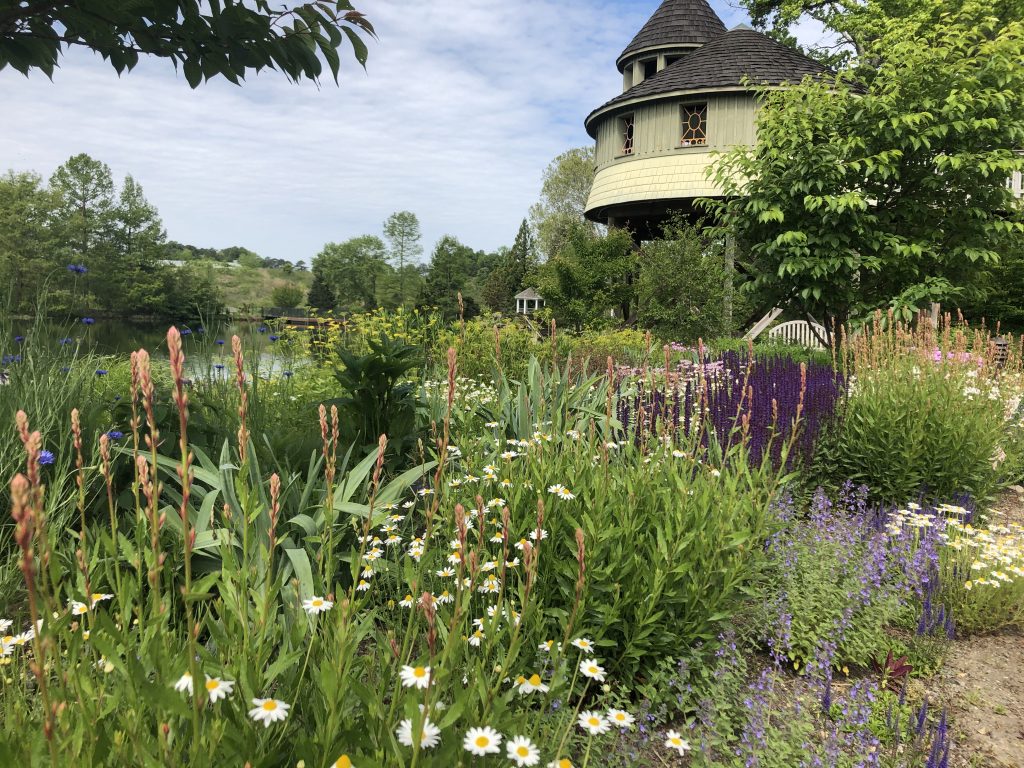
The space was created by Senior Horticulturist Elizabeth Fogel during her two-year tenure as the Garden’s first Frank Robinson Endowed Chair, and funded in part by a $100,000 Environmental Education grant from the U.S. Environmental Protection Agency. Fogel’s goal was to improve the aesthetics of a challenging site while addressing drainage issues and providing support for local pollinators. The result is a learning landscape, designed to demonstrate the practical use of ecological plantings in an attractive way that will inspire visitors to do the same in their home gardens.
Fogel and her fellow gardeners, supported by a cadre of volunteers, installed some 1,800 plants representing roughly 36 taxa around the lake edge. She worked with a diverse palette of mostly native species that have evolved to resist local pests and diseases, creating a relatively self-sustaining landscape that requires little in the way of fertilizer, pesticides, or extra water.
In spite of its natural look, the bed is far from formless. It has a blowsy, spontaneous feel, modulated by visible patterns, neat borders and signs of regular maintenance. Fogel organized the long, narrow space into three parallel bands. The shortest, more highly ornamental plants grow along the edge of the stone walkway, giving way to medium-height plants that fill the middle band. The third band, at the lake edge, is the most functional, populated by grasses and taller plants that help improve water infiltration.
Within each band she arranged plant species in layers — taller plants poke up through a carpet of ground cover that helps suppress weeds, in a practice known as “green mulch.” Drifts of color carry the eye across the landscape, naturalized in clumps of similar species punctuated by accent plants. Beginning near the lotus beds with pinks, purples, whites and yellows to keep the color cohesive, Fogel chose primarily flowering plants and distinctive foliage for their aesthetic value, sometimes taking advantage of existing plants like a group of 7-foot-tall silphium that she relocated to serve as a focal point in places where it was least likely to obstruct views of the lake.
Fogel shares a few of her favorite selections from the stylized riparian meadow:
Supporting Wildlife
Pollinators have different needs at different times in their life cycle. Fogel focused on plant diversity for the lake edge, to support every stage and to attract a wide variety of beneficial birds and insects.
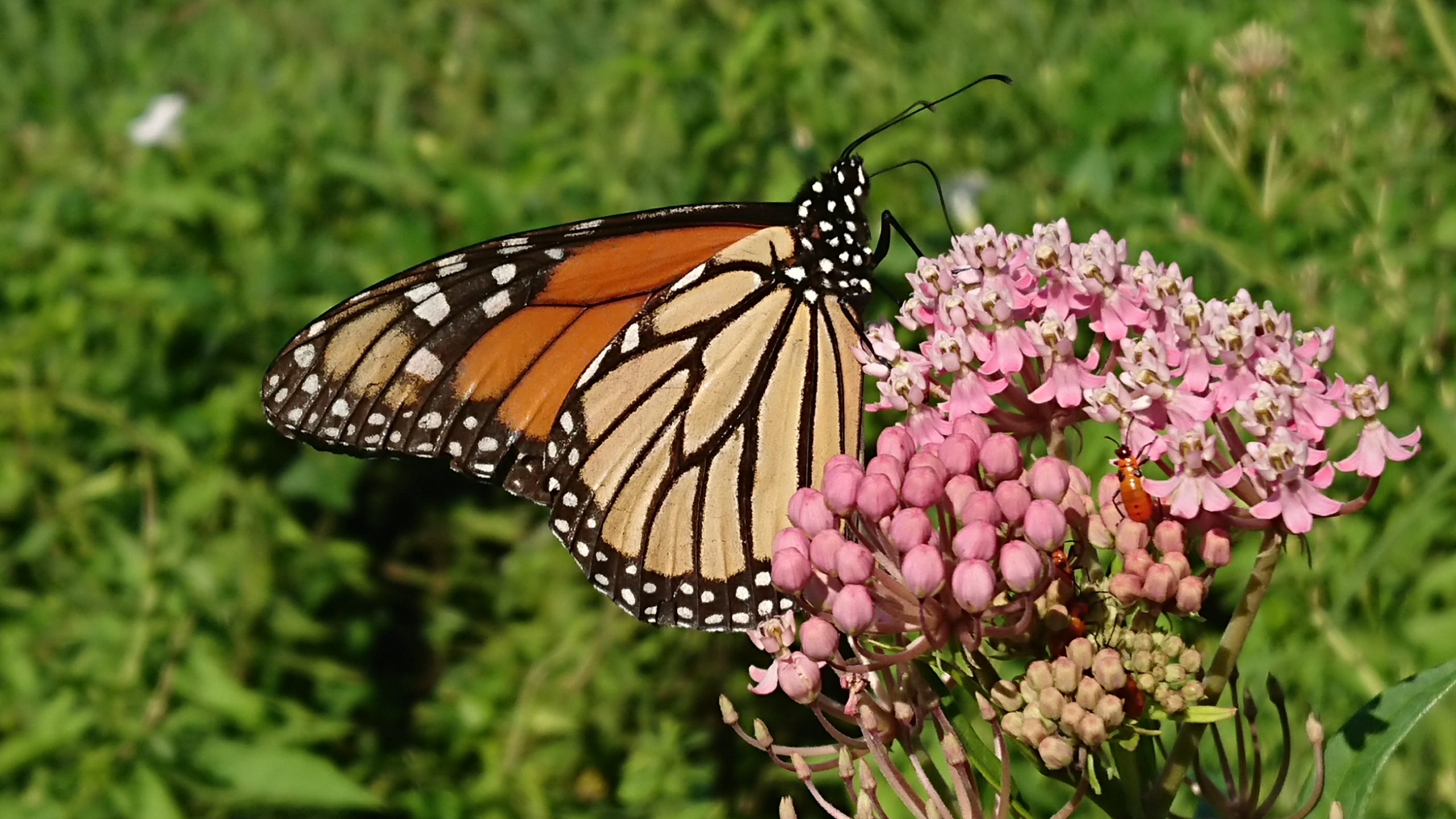
A hungry monarch sips nectar from Asclepias incarnata, (swamp milkweed) at the foot of the Lotus Bridge.
All summer long, the tight pink and mauve clusters of Asclepias incarnata, (swamp milkweed,) produce nectar for adult butterflies, while its leaves host the larvae stage of Monarch butterflies; bright yellow-orange bouquets of Asclepias tuberosa, or butterfly weed, and Zizia aurea, (golden Alexander,) serve the same purpose. Phlox maculata, commonly called spotted phlox, is attractive to butterflies, birds and hummingbirds while Solidago speciosa, also known as showy goldenrod, appeals to both bees and butterflies and hosts the larval stage of several species of moths, while goldfinches feed on the seeds.
Baptisia tinctoria or yellow wild indigo, is a larval host plant for several species of native butterflies, producing bright yellow to cream-colored clusters of pea-shaped blossoms in late spring. The tiny, bright purple flowers of Dalea purpurea, also called purple prairie clover, form dense, cone-shaped heads atop 1-3 inch stems, all summer long. Eryngium yuccifolium, or rattlesnake-master, is a member of the parsley/carrot family who’s globular, 1-inch diameter flower heads resemble silvery thistles. All three draw bees, butterflies and other beneficial insects to the lake edge to feed.
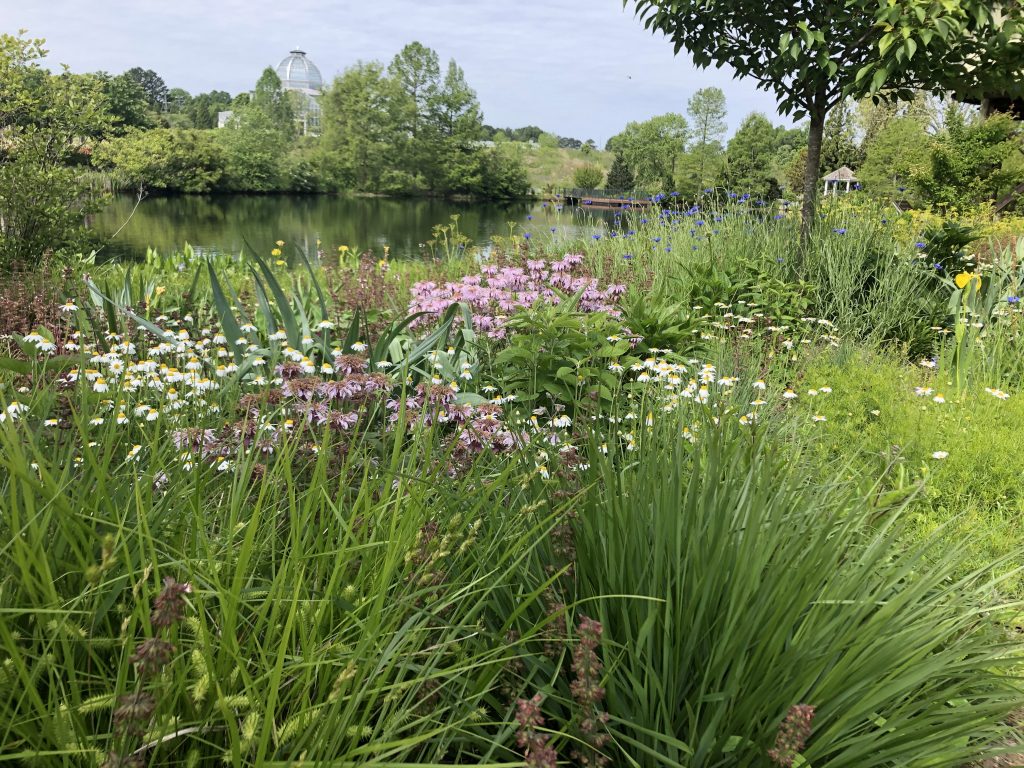
Native plantings like this wildflower meadow along Lake Sydnor help improve water quality, locally and in the Chesapeake Bay
Extending Seasons
In an effort to extend bloom times for a long as possible, Fogel planted a steady succession of seasonal ornamental highlights that flowers from early spring to late fall – for both the ecological benefit and the aesthetic value.
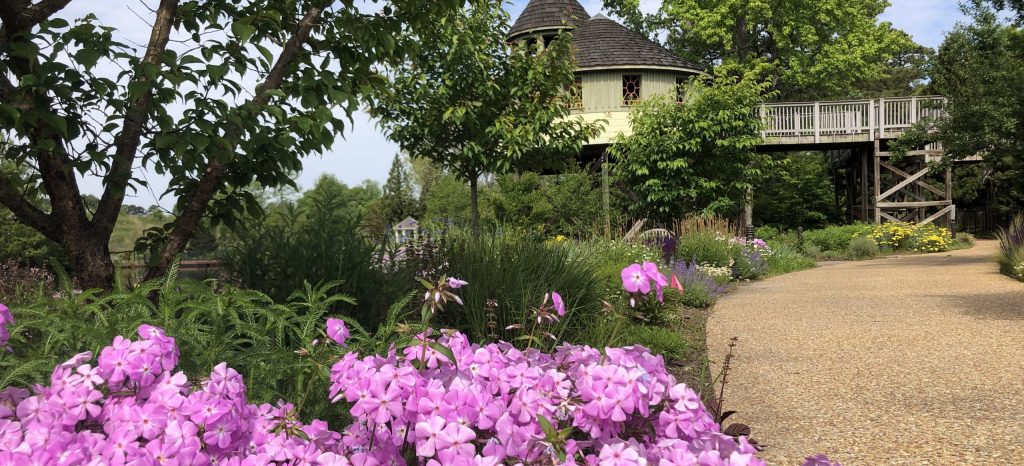
Phlox glaberrima ‘Morris Berd’ blooming in early spring along the stone pathway next to the Children’s Garden.
Phlox glaberrima ‘Morris Berd’, commonly called smooth phlox, is one of the few tall phloxes to bloom in early spring. In late spring, bees and butterflies feed on the lavender-blue spikes of Salvia lyrata, (or lyre-leaf sage). In early fall, Symphyotrichum ericoides, (heath aster,) bloom in dense sprays of daisy-like flowers that butterflies find especially attractive. Symphyotrichum lateriflorum, commonly known as calico aster, blooms from mid/late August into October. Fogel keeps the asters and other fall bloomers shorter and tidier by cutting them back to half their height once or twice in late spring or very early summer. Pruning before the end of June helps prevent a delay in their bloom time.
Stabilizing Soil
Grasses and sedges are great for water conservation because they have deep, fibrous roots that anchor soil, improve drainage and slow water flow, making them especially well-suited to erosion control.
For the Lake Sydnor restoration, Fogel chose more than ten species, including Bouteloua curtipendula with its distinctive oat-like seed spikes that hang from one side of its flowering stems, Schizachyrium scoparium, (little bluestem,) browsing in upright clumps of slender, flat, blue leaves that become bronze-orange in the fall and Sporobolus heterolepis, called prairie dropseed, forms arching mounds of fine leaves that turn golden in fall, fading to light bronze in winter. Leaving these grasses, as well as the flowering perennials, standing until very early spring provides vital overwintering shelter for birds and beneficial insects.
Bringing it Home
By creating a conservation landscape that is as appealing as it is functional, Fogel hopes to encourage homeowners to “consider replacing some bit of their own lawn, converting a more sterile landscape bed, or target a stormwater runoff collection site with this type of ecological landscaping.” That spot in the side yard that gets soggy after a storm or the depression that catches runoff from the driveway – anywhere that rainwater collects is an opportunity for water conservation that will help improve water quality locally and in the Chesapeake Bay.
All of the native plants growing in the new ecological landscape are suitable for home gardens, (see the full lake edge plant list (PDF) here.) The Virginia Native Plant Society offers a list of local growers that sell native plants. And, there are Virginia native plants available for purchase in the Garden Shop too! From the Shop offerings, Fogel recommends these alternatives that can be ordered online for curbside pick-up each Wednesday: Carex ‘Red Rooster’, Gaura ‘So White’, Monarda ‘Purple Rooster’, Pony Tails Feather Grass ‘Colorgrass’ and Wild Geranium.
Put some native plants to work in your yard! Grow your own conservation landscape. We hope you enjoy this video to see how beautiful it can be.
